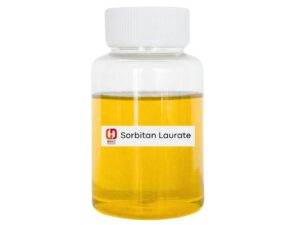Description
Sorbitan Tristearate: The Unsung Hero of Smooth and Stable Formulations
Sorbitan tristearate, often overlooked in the bustling world of cosmetic and food ingredients, is a versatile and valuable compound that plays a crucial role in stabilizing emulsions, modifying textures, and enhancing the overall performance of various products. While its name might sound intimidating, its function is relatively straightforward: it acts as an emulsifier and stabilizer, ensuring that oil and water-based ingredients play nicely together.
What is Sorbitan Tristearate?
Sorbitan tristearate is a non-ionic surfactant derived from sorbitol, a sugar alcohol, and stearic acid, a common fatty acid found in various vegetable oils. It appears as a waxy, tan-colored solid at room temperature and is practically odorless. Chemically, it’s an ester formed through the reaction of sorbitol with three molecules of stearic acid.
Why is it Used? The Power of Emulsification and Stabilization
The key to sorbitan tristearate’s effectiveness lies in its amphiphilic nature. This means it possesses both hydrophilic (water-loving) and lipophilic (oil-loving) properties. This dual affinity allows it to bridge the gap between oil and water phases in a formulation, preventing them from separating. Here’s a breakdown of its primary functions:
- Emulsification: Sorbitan tristearate helps to form and stabilize emulsions, which are mixtures of two or more immiscible liquids (like oil and water). It does this by lowering the surface tension between the liquids, allowing them to disperse evenly and create a consistent mixture.
- Stabilization: Once an emulsion is formed, it’s crucial to keep it stable over time. Sorbitan tristearate helps prevent the emulsion from breaking down, separating, or becoming grainy. This is vital for maintaining the desired texture and appearance of the product.
- Texture Modification: Beyond simple emulsification, sorbitan tristearate can also influence the texture of a product. It can contribute to a smoother, creamier, or more stable consistency.
- Viscosity Control: By influencing the interaction between different ingredients, sorbitan tristearate can help control the viscosity of a formulation, making it easier to apply or use.
Where Can You Find It? A Wide Range of Applications
Sorbitan tristearate is used in a diverse range of industries and products, including:
- Food Industry: It’s often found in chocolate, baked goods, and icings to prevent fat bloom (a white, chalky appearance on chocolate) and improve texture. It also helps stabilize vegetable oil-in-water emulsions like margarine and shortening.
- Cosmetics and Personal Care: In creams, lotions, and sunscreens, it acts as an emulsifier, ensuring a smooth and even distribution of ingredients. It can also contribute to the stability of makeup formulations like foundations and lipsticks.
- Pharmaceuticals: Sorbitan tristearate can be used as a stabilizer in drug formulations and topical ointments.
- Industrial Applications: It can be found in lubricants, coatings, and other industrial products where emulsification and stabilization are necessary.
Safety Considerations
Sorbitan tristearate is generally considered safe for use in food and cosmetic products. Regulatory bodies like the FDA have approved it for use within specific guidelines. However, as with any ingredient, it’s essential to use it in accordance with recommended concentrations and to consult with a qualified formulator or expert for specific applications.
In Conclusion: A Small Ingredient with a Big Impact
Sorbitan tristearate may not be a household name, but its contributions to product stability, texture, and overall performance are significant. It’s the unsung hero that ensures your chocolate stays smooth, your lotion stays creamy, and your sunscreen provides even coverage. Its ability to bridge the gap between oil and water makes it an indispensable ingredient for creating high-quality, stable, and appealing formulations across a wide range of industries. So, the next time you enjoy a perfectly textured product, remember the vital role played by sorbitan tristearate!













Reviews
There are no reviews yet.